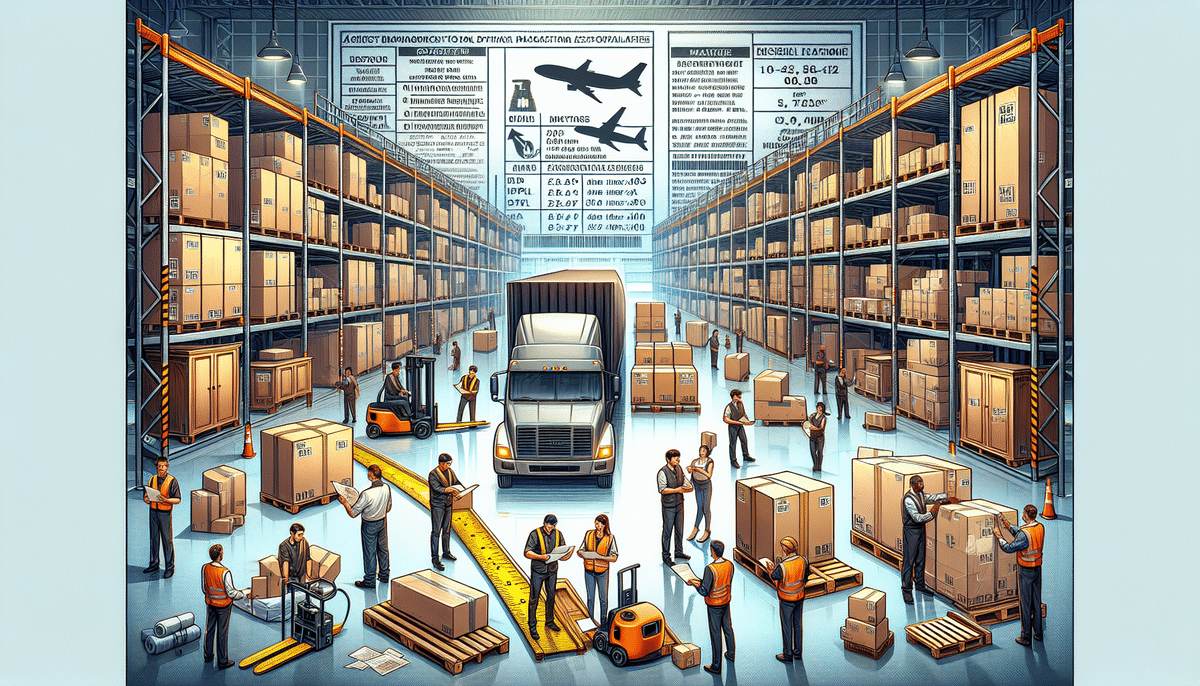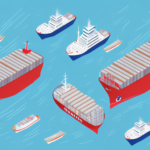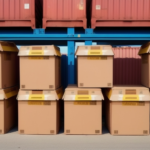Shipping Large Packages Over 202 Inches: Tips and Strategies
Shipping oversized packages measuring over 202 inches can be a daunting task, but it doesn't have to be. In this comprehensive guide, we'll explore the challenges, regulations, and best practices for shipping large and bulky items. By implementing these strategies, you will be equipped with the knowledge needed to confidently ship your oversized packages efficiently and safely.
The Challenges of Shipping Large Packages Over 202 Inches
Shipping oversized packages over 202 inches presents several challenges, including:
- Finding a carrier that can accommodate the size and weight of your cargo
- Complying with shipping regulations
- Ensuring the safe delivery of your shipment
- Special handling and packaging requirements, which can increase shipping costs
Additionally, oversized packages may face increased risk of damage during transit due to their size and weight. By understanding these challenges, you can better prepare for a successful delivery.
One of the biggest challenges of shipping oversized packages over 202 inches is the potential for damage during transit. Due to their size and weight, these packages are more susceptible to being bumped, dropped, or mishandled during loading and unloading. To mitigate this risk, consider the following strategies:
- Proper Packaging: Use appropriate packaging materials, such as foam padding or bubble wrap, to secure and protect your shipment.
- Insurance: Purchase shipping insurance to cover any potential damages that may occur during transit, providing peace of mind and financial protection.
Understanding the Shipping Regulations for Oversized Packages
Shipping regulations for oversized packages vary depending on the carrier, destination, and type of cargo being shipped. Generally, packages over 202 inches in length are considered oversized and may require:
- Additional documentation
- Specialized labeling
- Additional fees
It's crucial to research and understand the specific shipping regulations for your package to avoid any delays or issues during transportation. Refer to authoritative sources such as the U.S. Department of Transportation for detailed regulatory information.
Different carriers may impose varying weight restrictions for oversized packages. It's essential to:
- Verify that your package meets the carrier's weight restrictions
- Comply with any additional requirements they may have
Moreover, oversized packages may require special handling during transport, such as the use of specialized equipment or vehicles. Communicate any special handling requirements to your carrier to ensure that your package is transported safely and efficiently.
Choosing the Right Shipping Carrier for Your Large Package
Selecting the appropriate shipping carrier is essential for the successful delivery of your oversized package. Consider the following factors when choosing a carrier:
- Specialization: Opt for carriers that specialize in shipping oversized packages, as they possess the necessary equipment and expertise to handle your cargo.
- Pricing: Compare carrier pricing to ensure you are getting competitive rates.
- Delivery Speed: Evaluate the carrier's delivery timelines to meet your scheduling needs.
- Reputation: Research carrier reputation through reviews and industry ratings to ensure reliability.
Additionally, it's important to review the carrier's insurance policies and liability coverage. Ensure your package is fully insured in case of any damage or loss during transit. Some carriers may offer additional insurance options for high-value items, so inquire about these options if necessary. Investing time in researching and selecting the right carrier can save you time, money, and stress in the long run.
How to Measure and Weigh Your Large Package Accurately
Accurately measuring and weighing your oversized package is crucial for determining shipping costs and compliance with carrier requirements. Follow these steps to ensure precision:
- Measurement: Use a measuring tape to determine the package's length, width, and height.
- Weighing: Use a reliable scale to accurately weigh the package.
Most carriers calculate shipping costs based on dimensional weight, so it is essential to measure and weigh your package accurately to avoid overpaying for shipping.
Additionally, consider the packaging materials used for your oversized package. The weight of packaging materials can add up quickly, so:
- Subtract the weight of the packaging from the total package weight to obtain an accurate measurement.
- Use lightweight packaging materials to reduce the overall package weight, potentially saving on shipping costs.
If you're unsure about how to properly measure and weigh your oversized package, consider utilizing a professional shipping service. They have the necessary equipment and expertise to ensure accurate measurements and weights, helping you avoid unnecessary costs. Some shipping services even offer discounts for large or heavy packages, making them a cost-effective option for frequently shipping oversized items.
Packing Tips to Ensure Safe Delivery of Your Oversized Package
Proper packaging is essential to ensuring the safe delivery of your oversized package. Implement the following packing strategies:
- Sturdy Containers: Use sturdy boxes or crates that can support the weight of your cargo.
- Reinforcement: Reinforce any weak points with additional padding or packing materials to prevent structural damage.
- Specialized Packaging: Utilize specialized packaging designed for oversized packages, such as pallets or skids, to provide additional support during transport.
Another critical factor is proper labeling. Ensure your package is clearly marked with:
- The recipient's name and address
- Your own contact information
Clear labeling helps ensure that the package is delivered to the correct location and that you can be contacted in case of any issues or questions during the delivery process.
Shipping Insurance: Do You Need It for Your Large Package?
Shipping insurance provides valuable protection for your oversized package during transit. Consider the following when deciding on insurance coverage:
- Full Value Protection: Purchase insurance that covers the full value of your shipment, including the cost of the package and any associated fees, in the event of loss or damage.
- Cost-Benefit Analysis: Evaluate the value of the package contents. For particularly valuable or irreplaceable items, the extra cost of insurance is often justified.
- International Shipping: Research specific insurance requirements for destination countries to ensure compliance and adequate coverage.
While shipping insurance is not mandatory, it is highly recommended to mitigate potential losses. Be aware that some shipping carriers may offer limited liability coverage for free, but this coverage may not cover the full value of your package. Always read the carrier's terms and conditions carefully before deciding whether to purchase additional insurance.
Tracking Your Large Package: What You Need to Know
Tracking your oversized package during transport provides peace of mind and allows you to monitor the shipment's progress. Consider the following aspects when selecting tracking options:
- Tracking Services: Most carriers offer tracking services that enable you to view the package's current location and estimated delivery date.
- Advanced Tracking Options: Look for carriers that provide real-time updates or notifications via email or text message, especially useful for coordinating with the recipient or managing time-sensitive deliveries.
Be mindful that some carriers may charge additional fees for tracking services, particularly for oversized packages. Check with the carrier beforehand to avoid unexpected charges. Additionally, factors such as inclement weather, traffic, or other unforeseen circumstances can impact delivery times. If you encounter any unexpected delays or issues with your package, contact the carrier's customer service department for assistance. They can provide additional information or help resolve any problems that arise.
Common Mistakes to Avoid When Shipping Large Packages Over 202 Inches
When shipping oversized packages, avoiding common mistakes can prevent delays, damage, and additional fees. Key mistakes to avoid include:
- Inaccurate Measurement and Weighing: Ensure precise measurement and weighing to prevent overcharges and compliance issues.
- Inadequate Packaging: Use appropriate materials and techniques to protect your shipment from damage during transit.
- Non-compliance with Shipping Regulations: Research and adhere to carrier and destination-specific regulations to avoid legal issues.
- Choosing Inappropriate Carriers: Select carriers that specialize in oversized shipments to ensure proper handling.
Additionally, avoid the following mistakes:
- Improper Labeling: Clearly label the package with the recipient's address, your return address, and any necessary shipping instructions to ensure correct delivery and adherence to handling requirements.
- Ignoring Weather Conditions: Consider the impact of extreme temperatures, humidity, and precipitation on your package's condition. Choose carriers that offer temperature-controlled shipping options or use appropriate packaging materials to protect against environmental factors.
Cost Saving Strategies for Shipping Oversized Packages
Shipping oversized packages can be costly, but implementing strategic approaches can help reduce expenses. Consider the following cost-saving strategies:
- Select Carriers Offering Discounted Rates: Some carriers provide discounted rates for oversized packages. Compare different options to find the most competitive pricing.
- Consolidate Shipments: Combining multiple smaller packages into one larger shipment can lower overall shipping costs.
- Compare Carrier Pricing: Research and compare pricing from multiple carriers to ensure you are securing the best deal.
Additionally, optimizing your packaging to minimize size and weight can lead to significant savings. Utilizing lightweight yet durable packaging materials helps reduce dimensional weight and overall shipping costs.
International Shipping of Large Packages Over 202 Inches: What You Need to Know
Shipping oversized packages internationally introduces additional challenges beyond domestic shipping, including:
- Differing shipping regulations and compliance requirements across countries
- Applicable taxes and fees that vary by destination
- Customs documentation requirements
To ensure a smooth international shipment, it's important to:
- Research and understand the specific regulations, taxes, and fees for your destination country
- Prepare all necessary documentation in accordance with both the carrier's and destination country's requirements
- Consider working with a freight forwarder to navigate complex international shipping logistics
Failing to comply with international regulations can result in delays, additional costs, or even the seizure of your shipment. Always verify the requirements for your specific destination to avoid any unexpected issues during transport.
When to Consider Freight Shipping for Your Oversized Package
If your package exceeds the size or weight limits for standard parcel carriers, freight shipping may be a viable option. Freight shipping allows for the transport of oversized cargo via truck or train and is often more cost-effective for larger items. Consider the following when opting for freight shipping:
- Size and Weight: Assess whether your package surpasses standard carrier limits and determine if freight shipping is necessary.
- Cost-Efficiency: Compare the costs of freight shipping against standard parcel options to ensure financial viability.
- Specialization: Select a freight carrier that specializes in oversized shipments to ensure proper handling and transportation.
Freight shipping can offer advantages such as greater flexibility in shipment sizes and potentially faster delivery times for large items. However, it is essential to evaluate your specific shipping needs to determine if freight shipping is the most appropriate and cost-effective solution.
The Role of a Freight Forwarder in Shipping Large Packages Over 202 Inches
A freight forwarder plays a crucial role in streamlining the process of shipping oversized packages by managing key aspects such as:
- Logistics Management: Overseeing transportation routes and ensuring timely deliveries
- Documentation: Handling necessary shipping documents and customs paperwork for international shipments
- Carrier Communication: Coordinating with carriers to secure space and schedule shipments
Freight forwarders also provide valuable expertise in shipping regulations, customs requirements, and insurance options, helping to navigate the complexities of shipping oversized packages. By hiring a freight forwarder, you can ensure a hassle-free delivery process, mitigate potential issues, and focus on your core business operations.
Using Pallets for Safe and Secure Transportation of Your Oversized Package
Pallets provide an additional layer of protection and support for your oversized package during transportation. Implement the following best practices when using pallets:
- Appropriate Pallet Selection: Use pallets designed to handle the weight and size of your cargo to ensure stability.
- Secure Packaging: Strap or wrap your package securely to the pallet using strong straps or shrink wrap to prevent shifting during transit.
- Compliance for International Shipments: Utilize pallets that are ISPM-15 compliant to meet international shipping standards and avoid customs delays.
Properly using pallets can enhance the safety of your package, reduce the risk of damage, and streamline the handling process during transportation.
The Future of Shipping Large Packages Over 202 Inches: Emerging Technologies and Trends
The shipping industry is continually evolving, with emerging technologies and trends transforming how oversized packages are handled and transported. Key developments include:
- Drones for Last-Mile Delivery: The use of drones is revolutionizing last-mile delivery by providing faster and more efficient transportation of large packages to remote or congested areas.
- Automation in Warehouses: Increased automation in warehouses and distribution centers enhances efficiency and reduces the risk of human error in the handling of oversized shipments.
- Eco-Friendly Packaging Materials: The development of new, stronger, and more environmentally-friendly packaging materials supports sustainable shipping practices while maintaining package integrity.
Staying informed about these emerging trends can help you adapt and optimize your shipping strategies, ensuring the efficient and safe transportation of your oversized packages in the evolving landscape of the shipping industry.
Shipping oversized packages over 202 inches can be challenging, but by implementing the tips and strategies outlined in this guide, you can ensure the successful delivery of your large cargo. From selecting the right carrier and optimizing your packaging to understanding shipping regulations and effectively tracking your shipment, these best practices will empower you to navigate the complexities of oversized package shipping with confidence and efficiency.






















